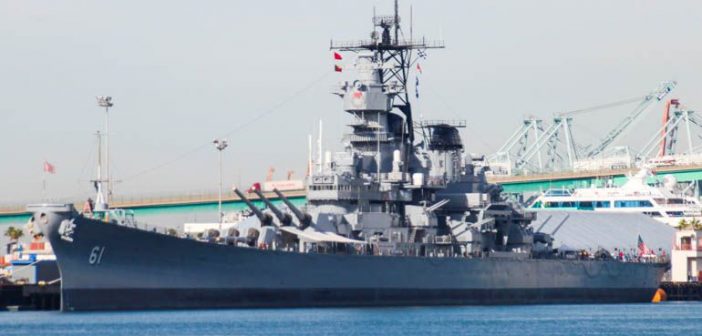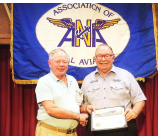 On Feb 8, 2018, the Grampaw Pettibone Squadron was honored to have as its guest speaker, Mr Joe Hughes. Mr.Hughes a volunteer on the USS Iowa anchored in San Pedro, CA provided the audience with a history of the restoration of the USS Iowa (BB-61) battleship and an overview of the ships anti-aircraft weapons operations during WWII. Joe has been a volunteer and docent on the Iowa since it first opened for public visits in 2012.
On Feb 8, 2018, the Grampaw Pettibone Squadron was honored to have as its guest speaker, Mr Joe Hughes. Mr.Hughes a volunteer on the USS Iowa anchored in San Pedro, CA provided the audience with a history of the restoration of the USS Iowa (BB-61) battleship and an overview of the ships anti-aircraft weapons operations during WWII. Joe has been a volunteer and docent on the Iowa since it first opened for public visits in 2012.
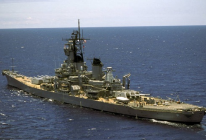 The USS Iowa was launched in June 1942 and commissioned in February 1943. She was first decommissioned in March 1949 and recalled to active duty two more times before a final decommission in October 1990. The Iowa was struck from the registry in March 2006. The ship located at Berth 87 in San Pedro, CA when active had a crew of 2800. It is 985 feet long and 102 feet wide. There are 18 decks from her original construction. The USS Iowa is the lead ship of the Iowa class of battleships. The other ships, all museums are: New Jersey in Camden, NJ; Missouri in Pearl Harbor, HI and Wisconsin in Norfolk, VA. The USS Iowa served three careers: WWII, Korea and during the arms buildup with the Russians in the 1980’s.
The USS Iowa was launched in June 1942 and commissioned in February 1943. She was first decommissioned in March 1949 and recalled to active duty two more times before a final decommission in October 1990. The Iowa was struck from the registry in March 2006. The ship located at Berth 87 in San Pedro, CA when active had a crew of 2800. It is 985 feet long and 102 feet wide. There are 18 decks from her original construction. The USS Iowa is the lead ship of the Iowa class of battleships. The other ships, all museums are: New Jersey in Camden, NJ; Missouri in Pearl Harbor, HI and Wisconsin in Norfolk, VA. The USS Iowa served three careers: WWII, Korea and during the arms buildup with the Russians in the 1980’s.
The Iowa had two engagement missions. First was carrier protection in a task force, which would be needed if task force protection from cruisers, destroyers and air assets failed to stop enemy aircraft from attacking the carrier. The second mission which was primary during the Korean conflict was naval bombardment. In the 1980’s the USS Iowa whose nickname was the ‘Big Stick’ had the role of showing the US flag around the world and to show the strength of the US. According to our speaker, the history of the Iowa included an event in April 1989 which resulted in an on-board explosion in the Number Two 16-inch gun turret. According to one investigation, during a practice firing, the breach was opened to accept a load and a pressure test on the ram was increased above normal. When the round and powder was rammed in, one of the powder bags more than 40 years old was leeching gas and when it was loaded, a spark ignited the powder, sending a fireball into the storage locker below the loading deck. A total of 47 personnel were killed. A memorial is conducted every year on the anniversary date of the event.
In addition to the ship’s history, a separate museum is scheduled to be opened on the Iowa in 2018 which will display artifacts from the collection of former Navy officer, oceanographer and underwater archaeologist, Robert Ballard. Mr. Ballard is best known for the research and recovery of artifacts from the Titanic. This museum will contribute to the funds required for maintaining and restoration of the hull, deck and other ship components.
After providing the overview of the USS Iowa, our speaker presented information describing each of the anti-aircraft systems installed on-board and the various engagements in which the ship participated. The on-board systems would be used depending on the mission. Prior to WWII, the missions were: fighting sea battles against the enemy, protection of carriers in task force and finally, shore bombardment. The mission order was changed based on actual events. They were: escort and protect carriers, shore bombardment and finally, sea battles.
The Iowa weapons system during WWII were a combination of anti-aircraft systems and large offensive naval guns. The first anti-aircraft weapon was Oerlikon 20mm single mount. These were manually maneuvered. 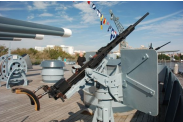 The Iowa was equipped with a total of 52 single mounts. While it could stop aircraft in flight, it was not considered effective against Kamikaze attacks, even though they were effective as a close in defensive response. The next system were the 40mm/.56 caliber Bofors. They were considered the best light anti-aircraft weapons of WWII. The Bofors could come as a single, double or quad mount. The Iowa carried 19 quad mounts, a total of 76 barrels. Next was the 5”/38 caliber twin mounts. A total of 20 cannon were on board.
The Iowa was equipped with a total of 52 single mounts. While it could stop aircraft in flight, it was not considered effective against Kamikaze attacks, even though they were effective as a close in defensive response. The next system were the 40mm/.56 caliber Bofors. They were considered the best light anti-aircraft weapons of WWII. The Bofors could come as a single, double or quad mount. The Iowa carried 19 quad mounts, a total of 76 barrels. Next was the 5”/38 caliber twin mounts. A total of 20 cannon were on board. 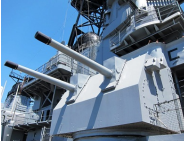
Mr. Hughes commented about the artifacts available on-board the USS Iowa to tell the story of the ship. There were only a few sample items to depict the on-board anti-aircraft systems. These consisted of a few 40mm and 20mm rounds, not considered sufficient to tell the whole story. A search was undertaken to locate an example of the 20mm Oerlikon and 40mm Bofors. One example of each was located and Mr. Hughes expressed the hope that each example will be acquired this year and a restoration will be undertaken to prepare each example for display. The display will be accompanied by video clips, crew and pilot interviews to bring the example of on-board anti-aircraft systems alive. Photos shown included the ships commissioning which displayed the weapons systems installed with the original configuration. Other photos displayed a picture of a 20mm gun mount. The traditional weapons system for the Iowa class Battleships was modified on the USS Iowa, since this vessel was designed as the flag-ship for the fleet. However, in order to protect the ship, any empty space was filled with an anti-aircraft system. Over the years the configuration changed to accommodate newer systems in order to meet newer need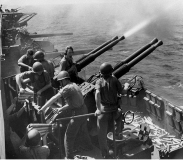 s. In the 1980s, the 5” guns were reduced to accommodate Tomahawk missiles and Harpoon anti-ship missiles. There are now 6 – 5” turrets reduced from the original 10.
s. In the 1980s, the 5” guns were reduced to accommodate Tomahawk missiles and Harpoon anti-ship missiles. There are now 6 – 5” turrets reduced from the original 10.
Mr. Hughes reviewed a sample of the weapons capabilities. Beginning with the 20mm Oerlikon, a 450 round per minute rate of fire with a maximum range of 2.7 miles and effective range of 1000 yards. It had a 5 man crew, 1 shooter, 1 supervisor and 3 loaders.
The next system is the Bofors 40mm which had a 160 round per minute rate of fire delivered in 4 round clips, 11 man crew with 3 to 4 operating the mount and the balance ammunition handlers. This weapon was used in conjunction with the Mark 51 Fire Control System which provided significant weapons operation and accuracy against selected targets.
The 5” guns remained, though newer versions with newer fire control systems were needed. A crew of 27 personnel manned each mount.
In December 1944, the USS Iowa was damaged as the result of a typhoon. One patrol plane was washed over-board and the shaft was damaged which required the ship to return to the US for repairs. In spite of the storm damage and return to the US, the ship was involved in 18 enemy engagements 1944-45. She was credited with destroying a total of 6 enemy aircraft, 3 solo and 3 assists.
At the end of the war as on-board systems were upgraded, crew compliment was also affected. Removal of older manually controlled systems that could not track jet powered aircraft fast enough, reduced crew requirements and the USS Iowa saw their service population go from 2800 to some 1700 personnel in the post war.
In answering questions, Mr. Hughes noted that any ship that is ported indefinitely must have the hull scraped every 30 years to prevent deterioration. Hull scraping last occurred in the early 80s for the Iowa. Further work will occur by creating a cofferdam, which creates a dry work space for hull repair. This workspace only offers a 6 foot work space which will require more than 10 years to scrape and repaint the 985 foot hull at the waterline.

